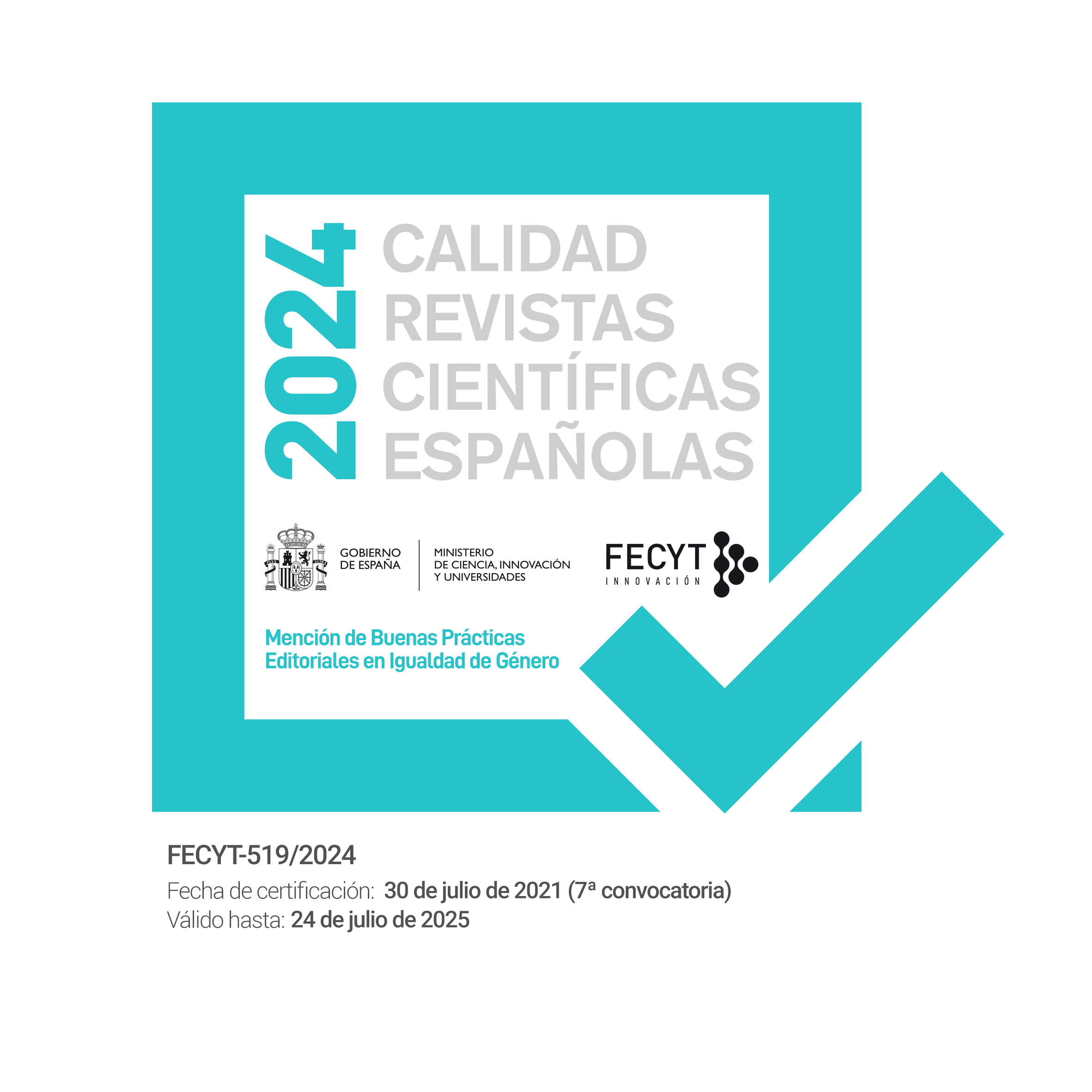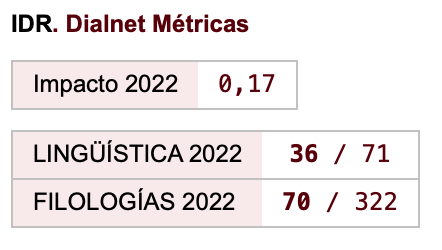Study for the validation of two instruments for the evaluation of foreign language learning websites
Keywords:
aprendizaje de segundas lenguas, competencia digital, competencia lingüística, evaluación de webs, validación instrumento de análisisAbstract
Language learning, as we know it today, has experienced a Copernican turn that - among other reasons - finds its roots in an unprecedented technological revolution, the creation of real communicative contexts, students’ motivation and need to learn new languages,and the ubiquity of learning. These factors make the combination of linguistic and digital competences a key construct of the learningprocess, which enables learners to access new access tools, platforms and online environments. The research project entitled “LinguApp: Asegurando el acceso al aprendizaje universal e inclusivo de segundas lenguas”, funded by Fundación Pública Andaluza Centro de Estudios Andaluces (Andalusian Regional Government), planned the development and validation of two instruments devoted to the assessment of websites for language learning. The first instrument evaluates the technical characteristics of the websites. The second instrument assesses more specifically which language skills are developed and how this process takes place by focusing on the contents andactivities that the given website offers. This paper presents the statistical results of the design and validation process, and concludes that this type of tools can decisively contribute to the development of research in this area, where technology has substantially modified theprocess of learning and teaching second languages.
Downloads
References
Barnes, S. y R. Vidgen (2002). An integrative approach to the assessment of e-commerce quality. Journal of Electronic Commerce Research, 3(3), 114-127.
Bass, B. M. (1983). Organizational decision making, Homewood, IL: Irwin.
Centro Virtual Cervantes (CVC). (2018). Diccionario de términos clave de ELE. <http://bit.ly/2OOoZEq> [17/08/2018].
Chen, W., Chia, G., Looi, C.K., Nooris, C., Soloway, E. y Zhang, B. (2011). 1:1 mobile inquiry learning experience for primary science students: a study of learning effectiveness. Journal of Computer Assisted Learning, 27(3), 269-287.
Cronbach, L.J. (1990). Essentials of psychological testing (5th ed.). New York: Harper Collins Publishers.
Davies, G. y Steel, D. (1981). First steps in Computer-Assisted Language Learning at Ealing College of Higher Education. <http://www.ict4lt.org/en/DaviesSteel1981.doc.> [16/08/2018].
Erbaggio, P., Gopalakrishnan, S., Hobbs, S. y Liu, H. (2012). Enhancing student engagement through online authentic materials. IALLT Journal of Language Learning Technologies, 42(2), 27–51.
Eshet-Alkali, Y. y Amichai-Hamburger, Y. (2004). Experiments in digital literacy. Cyberpsychology and Behavior, 7, 421–429.
Ganderton, R. (1998). New strategies for a new medium? Observing L2 reading on the world wide web. On-Call, 12(2), 2–9.
Ghareb, M.I., Sate-Askew, S. y Mohammed, S.A. (2018). Applying the New Paradigm of Anywhere Any Time in ESL Teaching Experience in the KRG Province Iraq. International Journal of Scientific & Technology Research, 7(5), 211-219.
Hafner, C.A., Chik, A. y Jones, R.H. (2015). Digital literacies and language learning. Language Learning & Technology, 19(3), 1-7. <http://llt.msu.edu/issues/october2015/commentary.pdf> [16/08/2018].
Hatlevik, O. E. y Christophersen, K.-A. (2013). Digital competence at the beginning of upper secondary school: Identifying factors explaining digital inclusion. Computers & Education, 63, 240–247.
Huizenga, J., Admiraal, W., Akkerman, S. y Dam, G.t. (2009). Mobile game-based learning in secondary education: engagement, motivation and learning in a mobile city game. Journal of Computer Assisted Learning, 25(4), 332-344.
Hung H-L., Altschuld, J.W. & Lee, Y. (2008). Methodological and conceptual issues confronting a cross-country Delphi study of educational program evaluation. Evaluation and Program Planning, 31, 191–198.
Hwang, G.J. y Tsai, C.C. (2011). Research trends in mobile and ubiquitous learning: a review of publications in selected journals from 2001 to 2010. British Journal of Educational Technology, 42(4), 65-70.
Hwang, W. Y., Chen, H. S., Shadiev, R., Huang, R. Y. M. y Chen, C. Y. (2014). Improving English as a foreign language writing in elementary schools using mobile devices in familiar situational contexts. Computer Assisted Language Learning, 27(5), 359-378. doi: 10.1080/09588221.2012.733711.
IEEE Std 1061, (1992). IEEE Standard for a Software Quality Metrics Methodology. IEEE Computer Society Press.
ISO/IEC 14598-5, (1998). International Standard: Information technology - Software product evaluation - Part 5: Process for evaluators. International Electrotechnical Commission.
ISO/IEC 9126, (1991). International Standard: Information technology - Software product evaluation - Quality characteristics and guidelines for their use. International Electrotechnical Commission.
Jakobson, R. (1985). Metalanguage as a Linguistic Problem. En S.R. Mouton (Ed.), Selected Writings, VII (pp. 113-121). <https://bit.ly/2MsNNEl> [16/08/2018].
Johnson, K. (2018). An Introduction to Foreign Language Learning and Teaching (Revised Third Edition). London: Routledge.
Johnson, S. (Ed.) (2012). Key issues for e-resource collection development: a guide for libraries. International Federation of Library Associations and Institutions (IFLA). < https://bit.ly/2RjIuWI> [24/10/2018].
Kern, R. (2015). Language, literacy, and technology. Cambridge: Cambridge University Press.
Kim, H. y Kwon, Y. (2012). Exploring smartphone applications for effective mobile-assisted language learning. Multimedia-Assisted Language Learning, 15(1), 31-57.
Kumaravadivelu, R. (1994). La situación posmétodo: estrategias emergentes y confluyentes para la enseñanza de segundas lenguas y de lenguas extranjeras. Antologías de textos de didáctica del español. <https://bit.ly/2BjN8k5> [17/08/2018].
Landeta, J. (2006). Current validity of the Delphi method in social sciences. Technological forecasting and social change, 73(5), 467-482.
Lee, K.W. (2000). English teachers’ barriers to the use of computer-assisted language learning. The Internet TESL Journal, 6(12), 1-8. doi: 10.1002/tesq.304.
Levy, M. (1997). CALL: Context and Conceptualisation. Oxford: Oxford University Press.
Levy-Magin, J.P. y Varela-Mallou, J. (2003). Análisis Multivariable para las Ciencias Sociales. Madrid: Pearson Prentice Hall.
Ludwig, B. G. (1997). Predicting the future: Have you considered using the Delphi methodology? Journal of Extension (electronic version), 35(5).
Mengual, S. (2011). La importancia percibida por el profesorado y el alumnado sobre la inclusión de la competencia digital en educación Superior. Alicante: Departamento de Didáctica General y Didácticas específicas de la Facultad de Alicante.
Nunnally, J. C. y Bernstein, I. H. (1994) Psychometric theory (3rd ed.). New York, NY: McGraw-Hill, Inc.
Núñez, M. (2002). Criterios para la evaluación de la calidad de las fuentes de información sobre salud en Internet. ACIMED, 10(5), 9-10. <https://bit.ly/2yzM1ck> [22/10/2018].
Pareja-Lora, A., Arús, J., Martín-Monje, E., Read, T., Pomposo-Yanes, L., Rodríguez-Arancón, P., ... Bárcena, E. (2013). Toward mobile assisted language learning apps for professionals that integrate learning into the daily routine. En L. Bradley y S. Thouësny (Eds.), 20 years of EUROCALL: Learning from the past, looking to the future. Proceedings of EUROCALL 2013 EUROCALL Conference, Évora, Portugal (pp. 206-210). Dublin: Research Publishing.
Parlamento Europeo y Consejo de la Unión Europea. (2006). Recomendación del Parlamento Europeo y del Consejo de 18 de diciembre de 2006 sobre las competencias clave para el aprendizaje permanente (2006/962/CE). Diario Oficial de la Unión Europea, L 394/10. <http://bit.ly/2wf0WH1> [20/08/2018].
Rivero, I. (2013). Criterios para seleccionar tecnologías educativas y estrategias didácticas en el Colegio Guillermo León Valencia. Educación y ciencia, 16, 37-52.
Román, E. (2002). Web-based Instructional Environments: Tools and Techniques for Effective Second Language Acquisition. International Journal of English Studies, 2(1), 31-58.
Rosell-Aguilar, F. (2018). Autonomous language learning through a mobile application: a user evaluation of the busuu app. Computer Assisted Language Learning, 2018, 1-28. doi: 10.1080/09588221.2018.1456465.
Savignon, S.J. (1991). Communicative language teaching: State of the art. TESOL Quarterly, 25(2), 261-278.
Sufeng, Y., Runjuan, S. y Liming, S. (2011). Computer-Assisted Language Learning in Higher Education. 2011 IEEE International Symposium on IT in Medicine and Education, Cuangzhou (pp. 137-141). doi: 10.1109/ITiME.2011.6130802.
Tafazoli, D., Gómez, M.E. y Huertas, C. A. (2018). Preface. En D. Tafazoli, M.E. Gómez y C. A. Huertas (Eds.), Cross-Cultural Perspectives on Technology-Enhanced Language Learning (pp. xx-xxvii). Hershey, PA: IGI Global.
Widdowson, H.G. (2004). Skills and knowledge in language learning. En M. Byram (Ed.), Routledge Encyclopedia of Language Teaching and Learning (pp. 548-553). Abingdon: Routledge.
Downloads
Published
How to Cite
Issue
Section
License
Authors who publish with this journal agree to the following terms:
- Authors retain copyright and grant the journal right of first publication with the work simultaneously licensed under a Creative Commons Attribution License that allows others to share the work with an acknowledgement of the work's authorship and initial publication in this journal.
- Authors are able to enter into separate, additional contractual arrangements for the non-exclusive distribution of the journal's published version of the work (e.g., post it to an institutional repository or publish it in a book), with an acknowledgement of its initial publication in this journal.
- Authors are permitted and encouraged to post their work online (e.g., in institutional repositories or on their website) prior to and during the submission process, as it can lead to productive exchanges, as well as earlier and greater citation of published work (See The Effect of Open Access).

Revista de Lenguas para fines específicos is licensed under a Creative Commons Reconocimiento-NoComercial-SinObraDerivada 4.0 Internacional License.
























